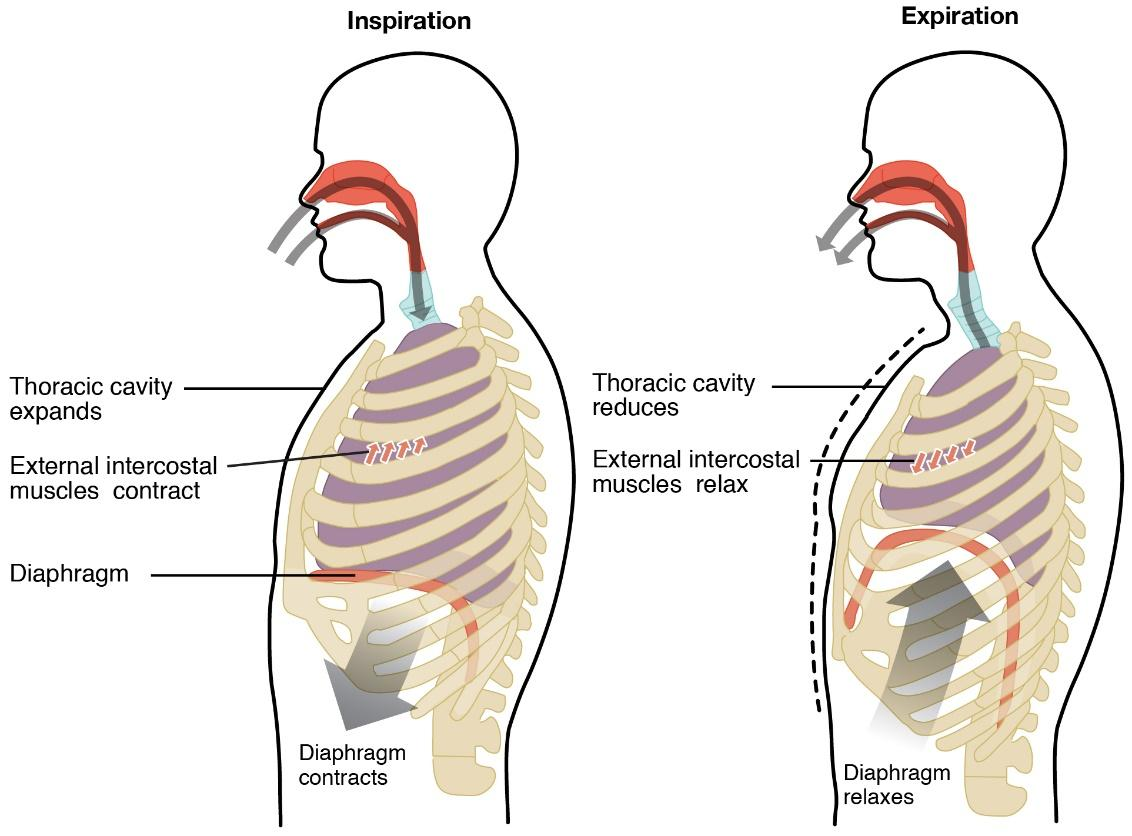
The size of the chest cavity increases during inhalation.
(A) True
(B) False
Answer
480.3k+ views
Hint: The lungs is the organ of the respiration. The respiration takes place in the two stages as the inhalation and the exhalation. The inhalation deals with the breathing in of the oxygen and the exhalation deals with the leaving out of the carbon dioxide as the metabolic waste product.
Complete Answer:
The thoracic pit, or chest cavity maintains the negative pressure which helps in keeping the aviation routes of the lungs open.
During the cycle of inward breath, the lung volume grows because of the constriction of the stomach and intercostal muscles (the muscles that are associated with the rib confine), consequently extending the thoracic cavity.
During this cycle, the diaphragm extends out and away from the lungs. The lungs are flexible; in this way, when air fills the lungs, the versatile force inside the tissues of the lung applies pressure back toward the inside of the lungs. These outward and internal powers contend to swell and empty the lung with each breath. Hence the chest cavity increases.

Upon exhalation, the intercostal muscles unwind, restoring the diaphragm to its unique position. During exhalation, the stomach likewise unwinds, moving higher into the thoracic cavity. Air surges out of the lungs because of the weight slope between the thoracic pit and the external environment. This causes the decrease in the area of the chest cavity.
Thus, the option (A) is correct.
Note: During the breathing in of the air, the ribs move upward and outward but during the breathing out the rib cage moves downward and the inward. The exchange of the gases takes place in the balloon like structures in the lungs called alveoli surrounded by the blood capillaries.
Complete Answer:
The thoracic pit, or chest cavity maintains the negative pressure which helps in keeping the aviation routes of the lungs open.
During the cycle of inward breath, the lung volume grows because of the constriction of the stomach and intercostal muscles (the muscles that are associated with the rib confine), consequently extending the thoracic cavity.
During this cycle, the diaphragm extends out and away from the lungs. The lungs are flexible; in this way, when air fills the lungs, the versatile force inside the tissues of the lung applies pressure back toward the inside of the lungs. These outward and internal powers contend to swell and empty the lung with each breath. Hence the chest cavity increases.

Upon exhalation, the intercostal muscles unwind, restoring the diaphragm to its unique position. During exhalation, the stomach likewise unwinds, moving higher into the thoracic cavity. Air surges out of the lungs because of the weight slope between the thoracic pit and the external environment. This causes the decrease in the area of the chest cavity.
Thus, the option (A) is correct.
Note: During the breathing in of the air, the ribs move upward and outward but during the breathing out the rib cage moves downward and the inward. The exchange of the gases takes place in the balloon like structures in the lungs called alveoli surrounded by the blood capillaries.
Recently Updated Pages
Express the following as a fraction and simplify a class 7 maths CBSE

The length and width of a rectangle are in ratio of class 7 maths CBSE

The ratio of the income to the expenditure of a family class 7 maths CBSE

How do you write 025 million in scientific notatio class 7 maths CBSE

How do you convert 295 meters per second to kilometers class 7 maths CBSE

Write the following in Roman numerals 25819 class 7 maths CBSE

Trending doubts
A boat goes 24 km upstream and 28 km downstream in class 10 maths CBSE

The Equation xxx + 2 is Satisfied when x is Equal to Class 10 Maths

What are the public facilities provided by the government? Also explain each facility

Difference between mass and weight class 10 physics CBSE

SI unit of electrical energy is A Joule B Kilowatt class 10 physics CBSE

Why is there a time difference of about 5 hours between class 10 social science CBSE




